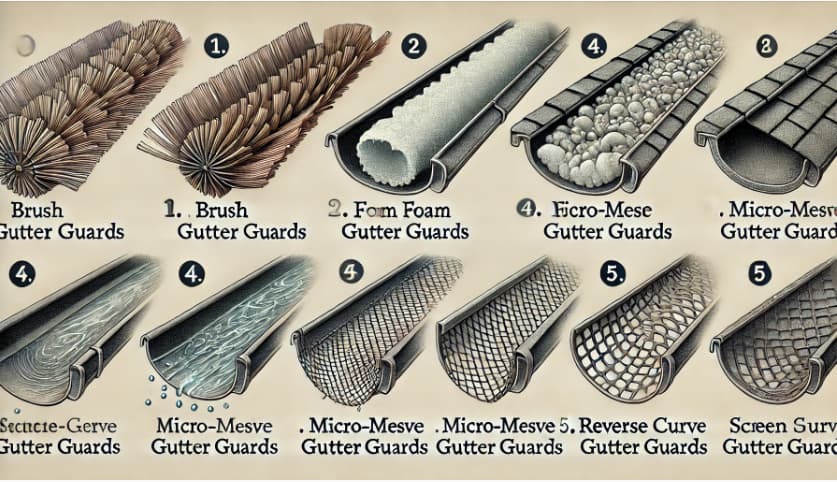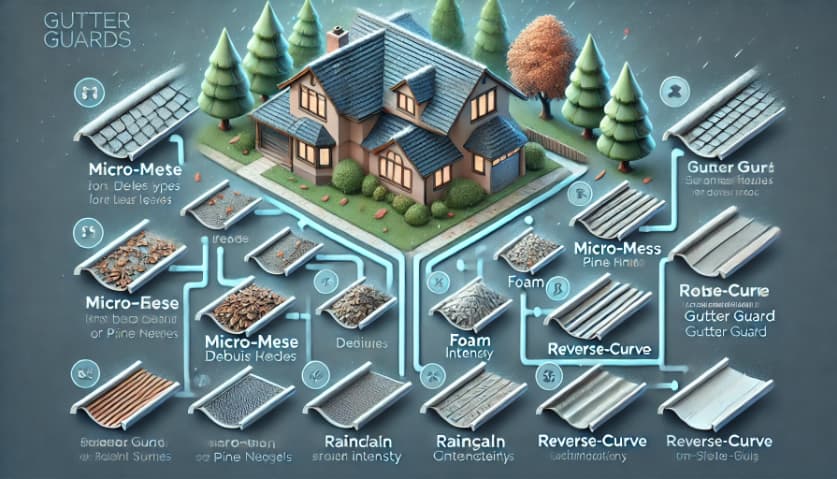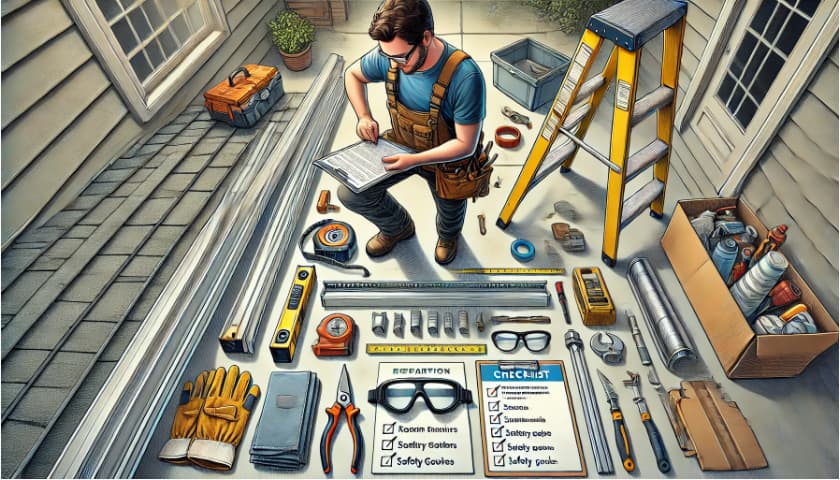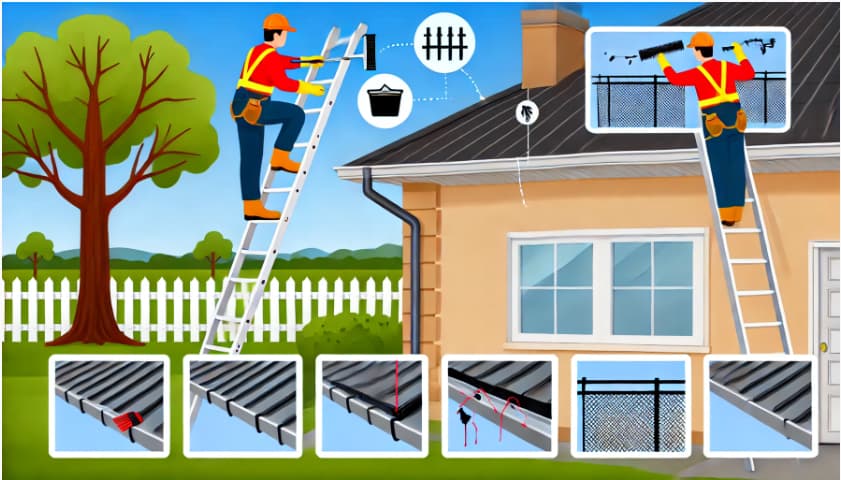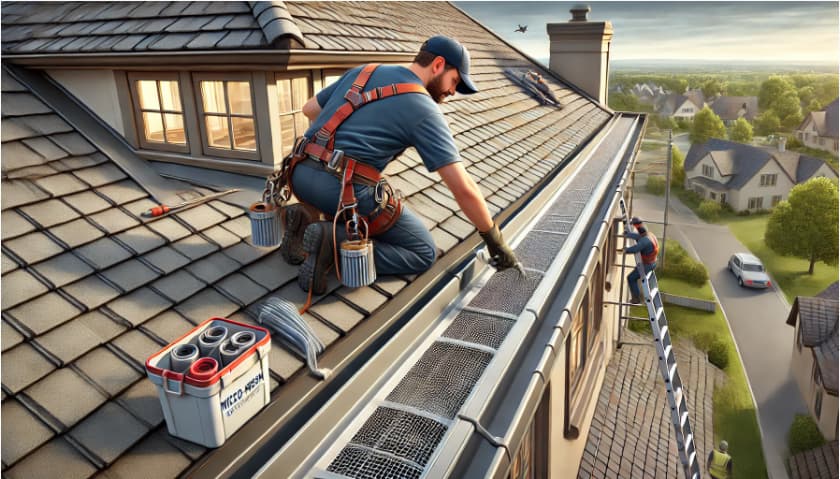Gutter Installation
How to Install Gutter Guards: A Comprehensive DIY Guide
How to Install Gutter Guards? Gutter guards are indispensable tools in home maintenance, crucial for safeguarding your home’s structural integrity.
These simple yet effective devices prevent leaves, twigs, and other debris from clogging your gutters, thus averting potential water damage that can be costly to repair.
Imagine the tranquility of knowing your home is shielded against the hazards of overflowing gutters, especially during heavy rainfalls.
Their utility extends beyond mere convenience; gutter guards significantly reduce the need for frequent gutter cleaning, cutting down on the labor and risk involved in climbing ladders to clear out blockages.
Moreover, by ensuring that water flows freely through your gutters and downspouts, these guards help prevent the formation of ice dams in colder climates, which can cause serious damage to your roof and gutters over time.
Gutter guards also contribute to the longevity of your roofing and drainage systems by minimizing the risk of rust and rot, common issues when debris retains moisture against these structures.
In addition, they protect against infestations by rodents and insects that might otherwise nest in clogged gutters.
Ultimately, the installation of gutter guards enhances not just the functionality of your home’s exterior but also its overall curb appeal, maintaining a neat and tidy appearance without the unsightly buildup of leaves and debris.
As you continue to read, you’ll learn exactly how to select, prepare, and install the right gutter guards for your home, ensuring you can enjoy these benefits year-round. Protect your home today with our top gutter guard picks!
2. Understanding Gutter Guards: Types and Functions
Gutter guards are designed to meet the diverse demands of different environments and homeowner needs, coming in a variety of styles each with unique characteristics and benefits:
Brush Guards:
- These guards resemble oversized pipe cleaners and are particularly effective at trapping larger debris like leaves and twigs.
Their simple design allows for easy installation directly into the gutter, making them a cost-effective and straightforward option for many homeowners.
However, their maintenance can be more frequent as smaller particles can get trapped in the bristles.
Foam Guards:
- Designed to fit snugly inside your gutters, foam guards block debris from entering while allowing water to pass through.
They are made from a porous material that absorbs water but blocks larger debris.
While foam guards are easy to install, they may require more maintenance to prevent mold and mildew, as the foam can retain moisture.
Micro-Mesh Guards:
- These feature an ultra-fine mesh that filters out almost all types of debris, from large leaves to finer particulates like pine needles.
Micro-mesh guards are highly effective at maintaining clear gutters in all conditions.
Due to their intricate design and the precision needed for optimal performance, professional installation is recommended to ensure they are correctly aligned and secured.
Reverse-Curve Guards:
- This type of guard uses a water adhesion method where water clings to the guard and flows into the gutter while debris falls over the edge.
Reverse-curve guards are excellent for reducing the amount of cleaning needed and can handle heavy water flow, making them suitable for regions with high rainfall.
Installation often requires adjustments to your roofline or gutter system, which might necessitate professional help.
Screen Guards:
- Offering a middle ground in terms of cost and functionality, screen guards provide basic filtration with a perforated cover over the gutters.
These are easier to install and work well in moderate climates where debris is not overly dense.
They allow for good water flow and are simpler to maintain than more complex systems. Find the best gutter guard for your home here.
3. Selecting the Right Gutter Guards for Your Home
Choosing the appropriate gutter guard is crucial to ensure effective protection and maintenance ease.
Various factors influence the selection process, tailoring it to your home’s specific environmental and structural conditions:
Type of Debris:
- The kinds of debris commonly found around your home play a significant role in determining the suitable type of gutter guard.
For example, homes surrounded by pine trees or coniferous forests will face a lot of fine needles, which can easily slip through larger mesh guards.
Micro-mesh or fine foam guards are preferable in such scenarios to prevent clogs effectively.
On the other hand, areas with larger debris, such as leaves and twigs, might find brush or screen guards adequate and more cost-effective.
Average Rainfall:
- The amount of rainfall your area receives is another critical factor. Homes in regions with high precipitation levels need gutter guards that can handle heavy water flow without overflowing.
Reverse-curve and micro-mesh guards are typically more efficient in these conditions, as they facilitate smoother water flow and reduce overflow risks.
Roof Material and Slope:
- The material of your roof and its slope also impact gutter guard functionality. For steep roofs, water runs off more quickly, increasing the potential for overflow if the gutter guards do not have adequate water throughput.
Screen or reverse-curve guards might be beneficial for these roofs as they are designed to manage swift water flow while filtering out debris effectively.
On the other hand, flatter roofs with less natural water flow may use foam or brush guards, which provide sufficient protection without the concern for rapid water drainage.
Local Weather Conditions:
- Besides rainfall, other weather conditions like wind intensity and the potential for snow and ice impact gutter guard choice.
Areas prone to heavy snowfall may benefit from heated gutter guards to prevent ice damming, which can damage your roof and gutters.
Conversely, in windy areas, securely fastened guards like bolted micro-mesh or reverse-curve systems are essential to prevent them from being dislodged.
Home Aesthetics and Installation Impact:
- Finally, consider the aesthetic impact of gutter guards and the nature of their installation.
Some guards, like micro-mesh and reverse-curve, may be more visible and require significant adjustments to your existing gutter system or roofline, potentially affecting the visual appeal of your home.
It’s important to choose guards that not only perform well but also blend with your home’s exterior design. Start selecting the right gutter guard for your environment here.
4. Preparing for Installation
Proper preparation is key to a successful and safe installation of gutter guards. Ensuring that you have all necessary tools and materials on hand before beginning the work can save you time and prevent accidents. Here’s a detailed guide on what you’ll need and how to prepare:
Tools and Materials Checklist:
- Sturdy Ladder: Ensure your ladder is robust and suitable for your house’s height. It should be stable and comply with safety standards to prevent falls.
Gloves: Wear thick, durable gloves to protect your hands from sharp edges and debris.
Shears or Tin Snips: Depending on the type of gutter guards you choose, you’ll need shears or tin snips to cut them to the appropriate length.
Gutter Guards: Have all your gutter guards purchased and on-site. Check them for any defects or damages before starting the installation.
Screws or Clips: Some gutter guards require specific fasteners. Make sure you have the correct type and quantity.
Measuring Tape: To accurately measure gutter lengths and ensure your guards are cut to the right size.
Marking Pencil: Useful for marking cutting lines directly on the gutter guards.
Level: To check that gutters are even and allow for proper water flow.
Safety Goggles: To protect your eyes from debris and dust during the cleaning and installation process.
Safety Precautions:
- Check the Weather: Ensure you choose a dry day for installation, as wet conditions can make roofs and ladders slippery and dangerous.
Secure the Ladder: Make sure the ladder is on stable ground and, if possible, have someone hold it at the base while you work to ensure stability.
Wear Appropriate Clothing: Besides gloves and safety goggles, wear long sleeves and trousers to protect your skin from scratches and irritations.
Be Mindful of Height: Always be conscious of your positioning and balance when on the ladder. Avoid overreaching; move the ladder frequently to stay directly in front of your work area.
Site Preparation:
- Clean the Gutters: Before installing the guards, thoroughly clean your gutters of all debris, leaves, and sediment.
This not only makes the installation smoother but also ensures the guards function correctly right from the start.
Inspect and Repair: While cleaning, inspect your gutters and downspouts for any signs of damage or wear, such as holes, rust, or disconnected joints.
Make necessary repairs or replacements to avoid future issues.
By carefully preparing and gathering all necessary tools and safety equipment, you can ensure that the installation of your gutter guards is a smooth, safe, and efficient process.
This careful preparation not only facilitates easier installation but also contributes to the longevity and effectiveness of your gutter guards, protecting your home against water damage for years to come. Get your essential installation tools and materials here.
5. Detailed Installation Guide
Installing gutter guards is a straightforward process that can significantly enhance your home’s drainage system efficiency and longevity. Here’s a step-by-step guide to ensure that your installation is done correctly:
1st Step: Clean Your Gutters
- Remove Debris: Begin by clearing out all leaves, twigs, and sediment from your gutters.
This can be done using a gutter scoop, garden hose, or a hand-held leaf blower for efficiency.
Flush Gutters with Water: After scooping, flush the gutters with a garden hose to remove any remaining small particles.
This will also help you identify any leaks or areas where water does not flow properly.
2nd Step: Measure and Cut the Gutter Guards
- Measure Gutter Lengths: Use a measuring tape to get the exact length of each gutter section.
Measurements should be accurate to ensure the guards fit perfectly without significant gaps.
Mark and Cut Guards: Lay out the gutter guards and mark the cutting lines based on your measurements.
Use shears or tin snips to cut the guards to the correct size, depending on the material type. Always wear gloves to protect your hands during this step.
3rd Step: Install the Gutter Guards
- Fit Guards into Place: Start at one end of the gutter and slide the first section of the guard under the roof shingles, if applicable.
Some guards are designed to snap onto the gutter edge or may require being screwed into place.
Secure the Guards: Use screws or clips to secure the gutter guards, ensuring they are snug and stable. This prevents them from lifting or shifting due to wind or the weight of debris.
Overlap Sections: If your guards are sectional, overlap each piece according to the manufacturer’s instructions to prevent gaps where debris could enter.
Check for Stability: Once all sections are installed, gently tug on them to ensure they are securely attached. Make any adjustments as necessary.
4th Step: Final Checks and Adjustments
- Inspect Installation: Walk along your gutter line and visually inspect each section of the gutter guard to ensure there are no gaps or loose areas.
Test with Water: Using a garden hose, simulate rainfall to check that water flows freely through the guards and that there are no overflows or blockages. Need help with installation? Find our guides and recommendations here.
6. Maintenance and Troubleshooting
Proper maintenance of your gutter guards is essential for ensuring they continue to function effectively and protect your home from water damage.
Here’s a guide to maintaining your gutter guards and troubleshooting common issues that might arise:
Regular Maintenance Tasks:
Periodic Inspections:
- Conduct visual inspections of your gutter guards at least twice a year, typically in the spring and fall. Look for any sections that appear to be sagging, detached, or clogged with debris.
Cleaning:
- Even with gutter guards, some small debris may accumulate on top of the guards or in the gutters themselves.
Use a soft brush or a leaf blower to clear away debris from the top of the guards. For more thorough cleaning, you may need to remove the guards, especially if you notice water not passing through as it should.
Flush the System:
- After removing debris, flush the gutters and downspouts with a garden hose to ensure water can flow freely. This will also help you spot any hidden clogs or leaks in the system.
Troubleshooting Common Issues:
Overflows:
- If you notice water spilling over the sides of your gutters during rainstorms, first check for and remove any debris blocking the guards.
If overflows continue, ensure that the gutter guards are properly aligned and that the gutter slope is correct to facilitate water flow towards the downspouts.
Guard Slippage:
- Sometimes, gutter guards may slip out of place if they weren’t secured properly during installation or due to heavy winds.
Realign any slipped guards and secure them with additional fasteners if needed.
Underperforming Guards:
- If you find that your gutter guards are not performing as expected, verify that you have the correct type of guards installed for your particular environment and roofing system.
For example, guards that are excellent for large debris may not perform well in areas with a lot of pine needles or fine particulates.
Seasonal Adjustments:
Prepare for Winter:
- In cold climates, check your gutter guards before winter to ensure they are secure and free of debris that could trap water and cause ice damming.
Consider installing heated gutter guards if ice dams have been a problem in the past.
Check After Severe Weather:
- After extreme weather conditions like heavy snowfalls or strong winds, perform an extra inspection to ensure the guards have not been damaged or dislodged.
By adhering to these maintenance and troubleshooting guidelines, you can maximize the lifespan and effectiveness of your gutter guards.
Regular care will not only keep your gutters functioning properly but also prevent more significant issues related to water damage, ensuring your home remains safe and dry throughout the year. Learn more about maintaining your gutter guards here.
7. When to Call a Professional
While many homeowners are comfortable undertaking a DIY installation of gutter guards, certain situations and conditions strongly suggest the need for professional assistance.
Understanding when to call in the experts can save you time, ensure optimal functionality, and prevent potential accidents. Here are key scenarios when you should consider professional installation:
Complex Roofline:
- If your home features a particularly steep, high, or intricately designed roofline, the challenges of installing gutter guards increase significantly.
Professionals have the tools, safety equipment, and experience to navigate complex roof architectures safely.
Comfort and Safety Concerns:
- Working on ladders or at heights isn’t for everyone. If you have any hesitation about climbing a ladder. Or if you lack the physical ability to perform the installation securely, it’s prudent to hire a professional.
They are trained to handle these conditions daily and have the necessary safety gear to prevent falls and injuries.
Specialized Gutter Guard Types:
- Certain types of gutter guards, especially those that require precise installation like micro-mesh or reverse-curve systems, benefit from professional installation.
These products often come with specific installation protocols that if not followed meticulously, can reduce their effectiveness and void warranties.
Regulatory Compliance:
- Some local regulations may require professional installation of home improvement products to comply with building codes or to maintain eligibility for insurance claims.
Professionals will ensure that all local codes are met and that your installation is up to standard.
Time and Efficiency:
- A professional can complete the job more quickly and efficiently than the average homeowner.
This is particularly valuable if you have a large home or if the weather forecast suggests upcoming storms.
Getting your gutter guards installed professionally and promptly can protect your home from imminent weather-related risks.
Guarantee and Peace of Mind:
- Many professional installations come with a warranty for both the product and the labor.
This not only ensures that your gutter guards are installed correctly but also covers any potential issues that might arise after installation, offering peace of mind that the job is guaranteed. Find reliable professional help for gutter guard installation here.
Conclusion:
Investing in the right gutter guards can significantly reduce the need for regular gutter cleaning and protect your home from water damage. By selecting the appropriate type and ensuring proper installation, you can enjoy both peace of mind and long-term savings.
Are you ready to tackle your next DIY project or perhaps you need a bit of professional guidance? Whether you’re looking to subscribe for more useful tips or need specific products, we’re here to help.
Does your home need gutter guards? Let us know below!
Don’t wait for the next storm! Secure your home with the best gutter guards available here.
Recent Posts
- Gutter Installation Guide: Protect Your Home
- Gutter Repair: Essential Tips and Costs
- Chimney Flashing Repair : Your Quick Fix Guide
- Roof Storm Damage Repair: Quick Recovery Tips
- Thatched Roofing: Embracing Eco-Friendly Tradition


